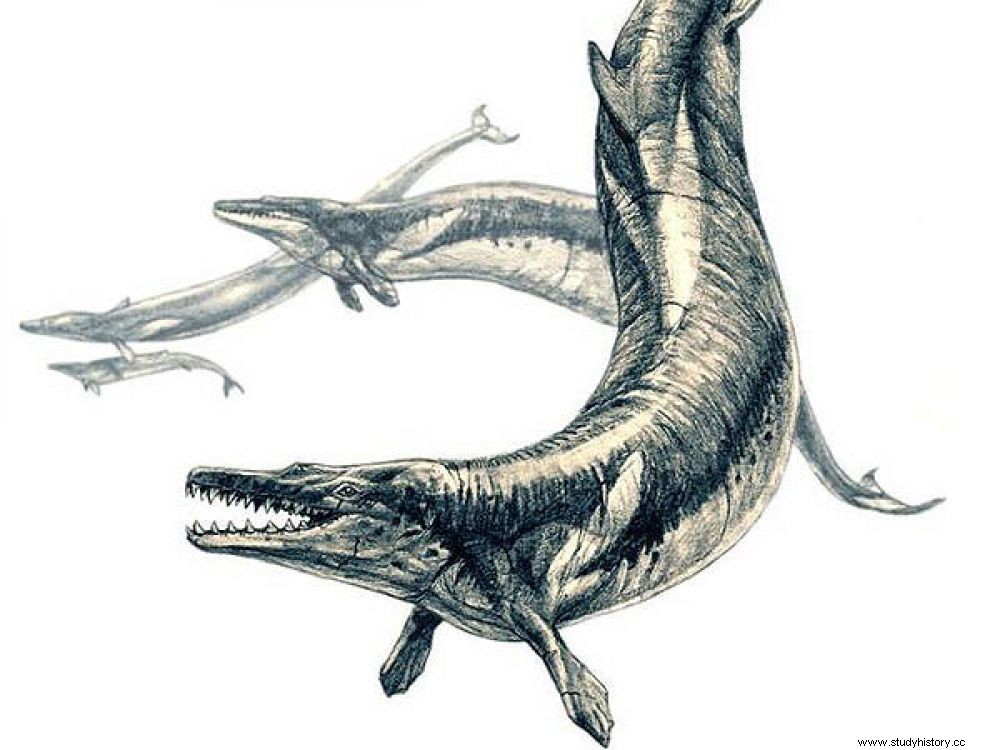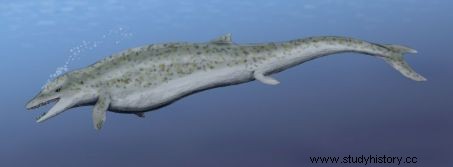The discovery of fossils of young primitive cetaceans positioned under the bones of Basilosaurus isis , another super-predatory cetacean 36 million years ago, suggests that the second devoured its own cousins.

Group of Basilosaurus, marine carnivores that populated the seas some thirty million years ago, at the end of the Eocene (illustration drawing).
We know the principle of nesting dolls:a large figurine that contains an identical figurine but of a smaller size, and so on... In nature, paleontologists can thus find fossils nested in each other, linked by the chain food, the remains of the prey being found in the carcass of the predators. For the first time, it's the meal of the terrible Basilosaurus isis , a giant cetacean (cousin of modern killer whales) with impressive rows of teeth, which paleontologists have been able to uncover.
A feast that included, among other things... other young carnivorous whales of the time, dorudons! Small carnivorous whales found in a huge carnivorous whale. Enough to refine the portrait of this super-predator of about fifty tons which sowed terror in the oceans more than 36 million years ago... The scientific article of the discovery was published in the journal PLOS One .
The last meal of a super-predator
The study is based on paleontological discoveries made in Egypt during the 20th century in the Wadi Al-Hitan, also called "valley of the whales". A UNESCO World Heritage Site since 2005, submerged by shallow waters a few million years ago, which made it a prime hunting area for ancient marine mammals. An exceptional site where a wide variety of fossilized marine animals have been found:whales, but also turtles, crocodiles, fish... including a fossil of Basilosaurus isis , a carnivorous cetacean 18 meters long... with its last undigested meal, consisting of young dorudons (Dorudon atrox ) was also fossilized!
We know the principle of nesting dolls:a large figurine that contains an identical figurine but of a smaller size, and so on... In nature, paleontologists can thus find fossils nested in each other, linked by the chain food, the remains of the prey being found in the carcass of the predators. For the first time, it's the meal of the terrible Basilosaurus isis , a giant cetacean (cousin of modern killer whales) with impressive rows of teeth, which paleontologists have been able to uncover.
A feast that included, among other things... other young carnivorous whales of the time, dorudons! Small carnivorous whales found in a huge carnivorous whale. Enough to refine the portrait of this super-predator of about fifty tons which sowed terror in the oceans more than 36 million years ago... The scientific article of the discovery was published in the journal PLOS One .
The last meal of a super-predator
The study is based on paleontological discoveries made in Egypt during the 20th century in the Wadi Al-Hitan, also called "valley of the whales". A UNESCO World Heritage Site since 2005, submerged by shallow waters a few million years ago, which made it a prime hunting area for ancient marine mammals. An exceptional site where a wide variety of fossilized marine animals have been found:whales, but also turtles, crocodiles, fish... including a fossil of Basilosaurus isis , a carnivorous cetacean 18 meters long... with its last undigested meal, consisting of young dorudons (Dorudon atrox ) was also fossilized!
"It's very rare, especially in fossil whales" , observes Manja Voss, of the Museum of Natural History in Berlin, co-author of the publication. "The diet of some past whale species still remains entirely unknown. This was the case for Basilausurus Isis before we began our investigation." "The challenge is to understand the ecological relationships between the different predators" in order to reconstruct the food chain of the time, she says. For the record, the first dorudons discovered were first taken for young Basilosaurus , so similar are the two species.

Drawing of a Dorudon atrox / Credits:Nobu Tamura / Creative Commons
Evaluate the position of two closely related species in the food chain
How the researchers were able to ensure that the young Dorudons had indeed been devoured by Basilosaurus, in other words, their fossils did not end up under a Basilosaurus rib cage by chance ? "The fossils allow us to affirm that Basilosaurus was their predator, thanks to several arguments" , continues Manja Voss. "They were found in a cavity matching the stomach of Basilosaurus, with teeth marks on the head matching that of the predator. In some cases the bones had obviously been broken by the bite."
However, one hypothesis remained to be ruled out:that of a scavenger activity of the little Dorudons, on a gigantic Basilausorus already dead. "It's not possible:they were unweaned youngsters, who had milk teeth" , details the specialist in marine mammals. What confirms the super-predator status of the terrifying Basilosaurus, which fed on large fish, but also young cetaceans. An ecological role today played by the orca (killer whale), still sometimes called "killer whale"... for a size however two to three times smaller. Tens of millions of years ago, Egypt must have been a terrifying place to dive.
